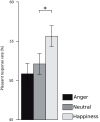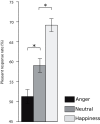Nonconscious influences from emotional faces: a comparison of visual crowding, masking, and continuous flash suppression
- PMID: 22563325
- PMCID: PMC3342619
- DOI: 10.3389/fpsyg.2012.00129
Nonconscious influences from emotional faces: a comparison of visual crowding, masking, and continuous flash suppression
Abstract
In the study of nonconscious processing, different methods have been used in order to render stimuli invisible. While their properties are well described, the level at which they disrupt nonconscious processing remains unclear. Yet, such accurate estimation of the depth of nonconscious processes is crucial for a clear differentiation between conscious and nonconscious cognition. Here, we compared the processing of facial expressions rendered invisible through gaze-contingent crowding (GCC), masking, and continuous flash suppression (CFS), three techniques relying on different properties of the visual system. We found that both pictures and videos of happy faces suppressed from awareness by GCC were processed such as to bias subsequent preference judgments. The same stimuli manipulated with visual masking and CFS did not bias significantly preference judgments, although they were processed such as to elicit perceptual priming. A significant difference in preference bias was found between GCC and CFS, but not between GCC and masking. These results provide new insights regarding the nonconscious impact of emotional features, and highlight the need for rigorous comparisons between the different methods employed to prevent perceptual awareness.
Keywords: CFS; GCC; consciousness; crowding; emotion; face processing; masking.
Figures







Similar articles
-
Affect of the unconscious: visually suppressed angry faces modulate our decisions.Cogn Affect Behav Neurosci. 2013 Mar;13(1):94-101. doi: 10.3758/s13415-012-0133-7. Cogn Affect Behav Neurosci. 2013. PMID: 23224765 Free PMC article.
-
A direct comparison of unconscious face processing under masking and interocular suppression.Front Psychol. 2014 Jul 7;5:659. doi: 10.3389/fpsyg.2014.00659. eCollection 2014. Front Psychol. 2014. PMID: 25071634 Free PMC article.
-
Multi-feature objects elicit nonconscious priming despite crowding.J Vis. 2011 Mar 3;11(3):2. doi: 10.1167/11.3.2. J Vis. 2011. PMID: 21372191
-
Continuous flash suppression: Known and unknowns.Psychon Bull Rev. 2020 Dec;27(6):1071-1103. doi: 10.3758/s13423-020-01771-2. Psychon Bull Rev. 2020. PMID: 32671572 Review.
-
Weighing the evidence for a dorsal processing bias under continuous flash suppression.Conscious Cogn. 2015 Sep;35:251-9. doi: 10.1016/j.concog.2014.12.010. Epub 2015 Jan 30. Conscious Cogn. 2015. PMID: 25649867 Review.
Cited by
-
Exposure is not enough: suppressing stimuli from awareness can abolish the mere exposure effect.PLoS One. 2013 Oct 17;8(10):e77726. doi: 10.1371/journal.pone.0077726. eCollection 2013. PLoS One. 2013. PMID: 24147067 Free PMC article.
-
Unconscious neural processing differs with method used to render stimuli invisible.Front Psychol. 2014 Jun 16;5:601. doi: 10.3389/fpsyg.2014.00601. eCollection 2014. Front Psychol. 2014. PMID: 24982647 Free PMC article.
-
Neural processing of visual information under interocular suppression: a critical review.Front Psychol. 2014 May 19;5:453. doi: 10.3389/fpsyg.2014.00453. eCollection 2014. Front Psychol. 2014. PMID: 24904469 Free PMC article. Review.
-
Spatial Frequency Tuning during the Conscious and Non-Conscious Perception of Emotional Facial Expressions - An Intracranial ERP Study.Front Psychol. 2012 Jul 19;3:237. doi: 10.3389/fpsyg.2012.00237. eCollection 2012. Front Psychol. 2012. PMID: 23055988 Free PMC article.
-
Comparing unconscious processing during continuous flash suppression and meta-contrast masking just under the limen of consciousness.Front Psychol. 2014 Sep 11;5:969. doi: 10.3389/fpsyg.2014.00969. eCollection 2014. Front Psychol. 2014. PMID: 25309469 Free PMC article.
References
-
- Baars B. (1997). “Contrastive phenomenology: a thoroughly empirical approach to consciousness,” in The Nature of Consciousness: Philosophical Debates, eds Block N., Flanagan O., Guzeldere G. (Cambridge: MIT Press; ), 187–201
LinkOut - more resources
Full Text Sources

